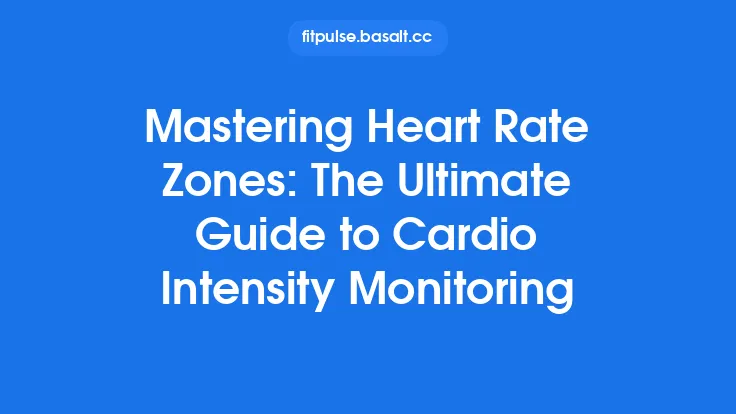Heart rate variability (HRV) has emerged as a powerful, non‑invasive metric for gauging the autonomic nervous system’s (ANS) response to exercise stress. By quantifying the fluctuations in time intervals between successive heartbeats, HRV offers insight into the balance between sympathetic (fight‑or‑flight) and parasympathetic (rest‑and‑digest) activity. This balance shifts in predictable ways when an athlete undergoes training, making HRV an invaluable tool for monitoring training load, optimizing performance, and reducing injury risk.
Understanding the Physiology Behind HRV
Autonomic Regulation of the Heart
The sinoatrial node, the heart’s natural pacemaker, generates electrical impulses that dictate each heartbeat. These impulses are modulated by two branches of the ANS:
- Sympathetic Nervous System (SNS): Increases heart rate and contractility, preparing the body for high‑intensity effort.
- Parasympathetic Nervous System (PNS), primarily via the vagus nerve: Decreases heart rate, promoting recovery and conserving energy.
HRV reflects the tug‑of‑war between these systems. High HRV generally indicates dominant parasympathetic tone and a well‑recovered state, whereas low HRV suggests sympathetic dominance, often associated with fatigue, stress, or insufficient recovery.
Time‑Domain and Frequency‑Domain Measures
HRV can be expressed through several mathematical approaches:
| Metric | Description | Typical Interpretation |
|---|---|---|
| SDNN (Standard Deviation of NN intervals) | Overall variability across the recording period | Lower values → reduced overall variability, possible overreaching |
| RMSSD (Root Mean Square of Successive Differences) | Short‑term variability, heavily influenced by vagal activity | Sensitive to acute recovery status |
| pNN50 / pNN20 | Percentage of successive intervals differing by >50 ms / >20 ms | Higher percentages → stronger parasympathetic influence |
| LF (Low Frequency, 0.04–0.15 Hz) | Reflects both sympathetic and parasympathetic activity | Elevated LF may indicate stress or training load |
| HF (High Frequency, 0.15–0.40 Hz) | Primarily parasympathetic (vagal) activity | Decreased HF suggests reduced recovery |
| LF/HF Ratio | Balance between sympathetic and parasympathetic influences | Higher ratios → sympathetic dominance, potential overtraining |
Time‑domain metrics are easier to compute and are often preferred for daily monitoring, while frequency‑domain analyses provide deeper insight into autonomic balance but require more sophisticated equipment and software.
HRV as a Marker of Training Load
Acute vs. Chronic Load
- Acute training load refers to the stress imposed by a single session or a short series of sessions (e.g., a week). HRV measured immediately after or the day after a workout can reveal the immediate autonomic response.
- Chronic training load reflects the cumulative stress over longer periods (e.g., 3–4 weeks). Tracking HRV trends over weeks helps identify whether the athlete is adapting positively, plateauing, or heading toward maladaptation.
The “HRV‑Training Load” Relationship
Research consistently shows a biphasic HRV response to training:
- Initial Decrease: After a novel or high‑intensity stimulus, HRV drops as sympathetic activity rises to meet the demand.
- Recovery Phase: With adequate rest, parasympathetic tone rebounds, often surpassing baseline HRV—a phenomenon known as “supercompensation.”
- Adaptation Plateau: Over time, a well‑programmed training plan leads to a higher resting HRV baseline, indicating improved autonomic resilience.
If HRV remains depressed for several consecutive days despite rest, it may signal insufficient recovery, excessive load, or emerging illness.
Practical Implementation for Monitoring
Choosing the Right Device
Modern HRV monitoring can be performed with:
- Chest strap ECG sensors (e.g., Polar H10) – gold standard for accuracy.
- Photoplethysmography (PPG) wrist or finger devices – convenient but may be susceptible to motion artefacts.
- Dedicated HRV apps that integrate with Bluetooth sensors and provide automated analysis (e.g., Elite HRV, HRV4Training).
When selecting a device, prioritize validated ECG‑based measurements for training‑load decisions.
Standardizing Measurement Conditions
To obtain reliable data, follow a consistent protocol:
- Time of Day: Measure first thing in the morning, before caffeine, food, or exercise.
- Posture: Supine or seated, with a stable position for at least 5 minutes.
- Breathing: Natural breathing is acceptable; however, a controlled breathing rate (≈0.1 Hz, or 6 breaths per minute) can reduce variability for research‑grade assessments.
- Environment: Quiet, temperature‑controlled room to minimize external stressors.
Consistency reduces noise and enhances the sensitivity of HRV to training‑related changes.
Data Collection Frequency
- Daily measurements provide the most granular view of autonomic fluctuations and are ideal for athletes with high training volumes.
- Three‑times‑per‑week sampling can be sufficient for recreational exercisers or when resources are limited, provided the days are evenly spaced.
Interpreting the Data
- Baseline Establishment: Record HRV for at least 7–14 consecutive days under stable training conditions to define an individual baseline (mean ± SD).
- Threshold Setting: Common practice uses a “±0.5 SD” window. Values falling below this lower bound for two consecutive days may trigger a recovery intervention.
- Trend Analysis: Plot rolling averages (e.g., 7‑day moving average) to smooth day‑to‑day noise and reveal longer‑term patterns.
- Contextual Integration: Pair HRV data with subjective measures (e.g., perceived fatigue, sleep quality) and objective load metrics (e.g., session RPE, volume) for a holistic view.
Integrating HRV into Periodization Strategies
Macro‑Cycles and HRV
During the preparatory phase, a gradual increase in training load often coincides with a modest dip in HRV, followed by a rebound as the athlete adapts. Monitoring HRV helps confirm that the intended adaptation is occurring and that the athlete is not slipping into chronic fatigue.
Tapering
A well‑executed taper typically yields a noticeable rise in HRV, reflecting restored parasympathetic dominance. Coaches can use HRV spikes to fine‑tune taper length—if HRV plateaus early, the taper may be shortened; if HRV continues to climb, a longer taper could be beneficial.
Overreaching vs. Overtraining
- Functional overreaching is a short‑term, intentional increase in load that leads to performance gains after recovery. HRV may dip sharply but rebounds within a week.
- Non‑functional overtraining manifests as prolonged HRV suppression (≥2 weeks) accompanied by performance decline, mood disturbances, and increased illness risk.
Early detection via HRV allows for timely load adjustments, preventing the transition from functional overreaching to pathological overtraining.
Limitations and Considerations
Inter‑Individual Variability
HRV is highly personal; absolute values differ widely across age, sex, genetics, and fitness level. Therefore, reliance on population norms is inappropriate—individual baselines are essential.
Influencing Factors Beyond Training
- Sleep quality and quantity
- Psychological stress (work, relationships)
- Hydration and nutrition status
- Alcohol, caffeine, and medication intake
- Illness or subclinical infections
These variables can confound HRV readings. A comprehensive monitoring system should capture these contextual data points.
Measurement Artefacts
Motion artefacts, poor sensor contact, and irregular breathing can distort HRV calculations. Regular device maintenance, proper sensor placement, and adherence to measurement protocols mitigate these issues.
Data Over‑Interpretation
While HRV is a sensitive marker, it is not a standalone diagnostic tool. Decisions should be corroborated with performance metrics, training logs, and athlete feedback to avoid unnecessary training reductions.
Case Study: Applying HRV in a Competitive Cyclist’s Program
Background: A 28‑year‑old elite cyclist follows a 12‑week periodized plan, incorporating high‑intensity interval sessions (HIIT), long endurance rides, and strength work.
Implementation:
- Baseline: 14 days of morning supine HRV (RMSSD) recorded, mean = 68 ms, SD = 7 ms.
- Monitoring: Daily RMSSD logged; a 7‑day moving average calculated.
- Load Integration: Session RPE multiplied by duration (training impulse, TRIMP) logged each day.
Observations:
- Weeks 3‑4 (HIIT block): RMSSD dropped to 55 ms (≈‑2 SD) for three consecutive mornings. Training load was reduced by 20 % the following week, focusing on low‑intensity rides. RMSSD rebounded to 70 ms within five days.
- Weeks 7‑8 (Taper): RMSSD rose steadily to 80 ms, exceeding baseline by >1 SD, coinciding with a 30 % reduction in volume. The athlete reported feeling “fresh” and posted a personal best in a time‑trial.
- Weeks 10‑11 (Unexpected illness): RMSSD fell sharply to 45 ms despite unchanged training load. The athlete was diagnosed with a mild viral infection; training was paused, and HRV returned to baseline after recovery.
Outcome: By integrating HRV, the coach could pre‑emptively adjust load, optimize taper, and identify non‑training‑related stressors, ultimately contributing to a peak performance at the target race.
Best‑Practice Checklist for Practitioners
| ✅ | Action |
|---|---|
| 1 | Select a validated ECG‑based HRV sensor and ensure regular calibration. |
| 2 | Establish a 2‑week baseline under stable training, sleep, and nutrition conditions. |
| 3 | Standardize measurement protocol (morning, supine, 5‑minute recording). |
| 4 | Record daily RMSSD (or SDNN) and calculate a 7‑day moving average. |
| 5 | Log training load (e.g., TRIMP, session RPE) alongside HRV. |
| 6 | Collect contextual data (sleep, stress, hydration, illness). |
| 7 | Set individualized thresholds (e.g., < 0.5 SD below baseline for 2 days). |
| 8 | Adjust training (reduce volume/intensity, add recovery) when thresholds are breached. |
| 9 | Re‑evaluate after interventions to confirm HRV rebound and performance maintenance. |
| 10 | Educate athletes on the purpose of HRV monitoring to encourage compliance. |
Future Directions in HRV Research
- Machine‑Learning Integration: Combining HRV with multi‑modal data (e.g., wearable sleep metrics, hormonal assays) to predict performance outcomes with higher precision.
- Individualized Autonomic Profiles: Developing algorithms that account for genetic markers influencing autonomic regulation, enabling truly personalized load prescriptions.
- Real‑Time Feedback Systems: Wearables that provide instantaneous HRV‑based alerts during training sessions, allowing on‑the‑fly adjustments.
- Longitudinal Population Studies: Expanding datasets across diverse sports, ages, and genders to refine normative ranges and improve the specificity of HRV thresholds.
Bottom Line
Heart rate variability offers a window into the autonomic nervous system’s response to training stress, making it an indispensable metric for monitoring training load. When measured consistently, interpreted alongside contextual factors, and integrated into periodized programming, HRV helps athletes and coaches strike the optimal balance between stimulus and recovery—maximizing performance while safeguarding health. By embracing HRV as a core component of the training monitoring toolkit, practitioners can move from reactive adjustments to proactive, data‑driven decision‑making.





